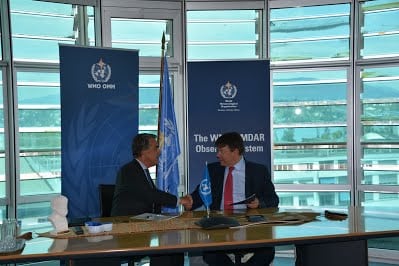
WMO Secretary-General Petteri Taalas met IATA Director General Alexandre de Juniac to discuss how IATA’s 265 airlines in over 117 countries can best contribute to AMDAR’s data gathering system. Photo courtesy of WMO
The International Air Transport Assn. (IATA) has agreed to a new arrangement that will help expand a global aviation weather monitoring system that currently produces 700,000 weather observations per day. Under a new agreement, IATA and the World Meteorological Org. (WMO) will attempt to expand the current operations of the global Aircraft Meteorological Data Relay (AMDAR) system.
According to WMO, the AMDAR system was launched in the 1980s, as an extension of the organization’s Global Telecommunications System (GTS). Through data and information collected by aircraft avionics, onboard sensors, and communications systems, AMDAR uses data links to transmit information to ground automation stations.
WMO’s GTS processes the data once it reaches the ground stations and then relays the two nationally operated meteorological and hydrological weather services. AMDAR’s 700,000 daily weather observations feature air temperature and wind speed and direction, together with the required positional and temporal information and with an increasing number of humidity and turbulence measurements being made.
Data collected by AMDAR is used for weather monitoring and prediction for commercial aviation operators worldwide. However, the data is also used for other weather related processes, such as public weather forecasting, climate monitoring and prediction.
Avionics companies such as Honeywell Aerospace, Rockwell Collins and service providers such as Gogo, among others, have also made efforts recently to improve the way airlines obtain updates about weather in various areas of airspace all over the world. The focus for avionics manufacturers and internet service providers has been developing the concept of crowdsourced weather for aviation. This is the process of turning existing aircraft weather radars into connected radars that downlink information about airspace conditions and continuously delivering updates as needed to subscribers of that information.
WMO Secretary-General Petteri Taalas recently met IATA Director General Alexandre de Juniac to discuss how IATA’s 265 airlines in more than 117 countries can best contribute to AMDAR’s data gathering system.
The organization also formed an agreement with the International Civil Aviation Org. (ICAO) in April to discuss how to strengthen cooperation between national meteorological and hydrological services and civil aviation administrations. Under that agreement, the two organizations are attempting to establish an operational space weather service for international air navigation by November 2018.
Stewart Taylor, a senior operational meteorologist told Avionics that the focus of the collaboration between IATA and WMO, will be an effort to “expand the AMDAR network to areas where atmospheric data (wind/temp) is sparse.”
Additionally, the IATA-WMO collaboration will research what’s required to develop a commercial airline turbulence database to provide airlines with enhanced turbulence forecasting and also to protect their data from misuse by third parties.